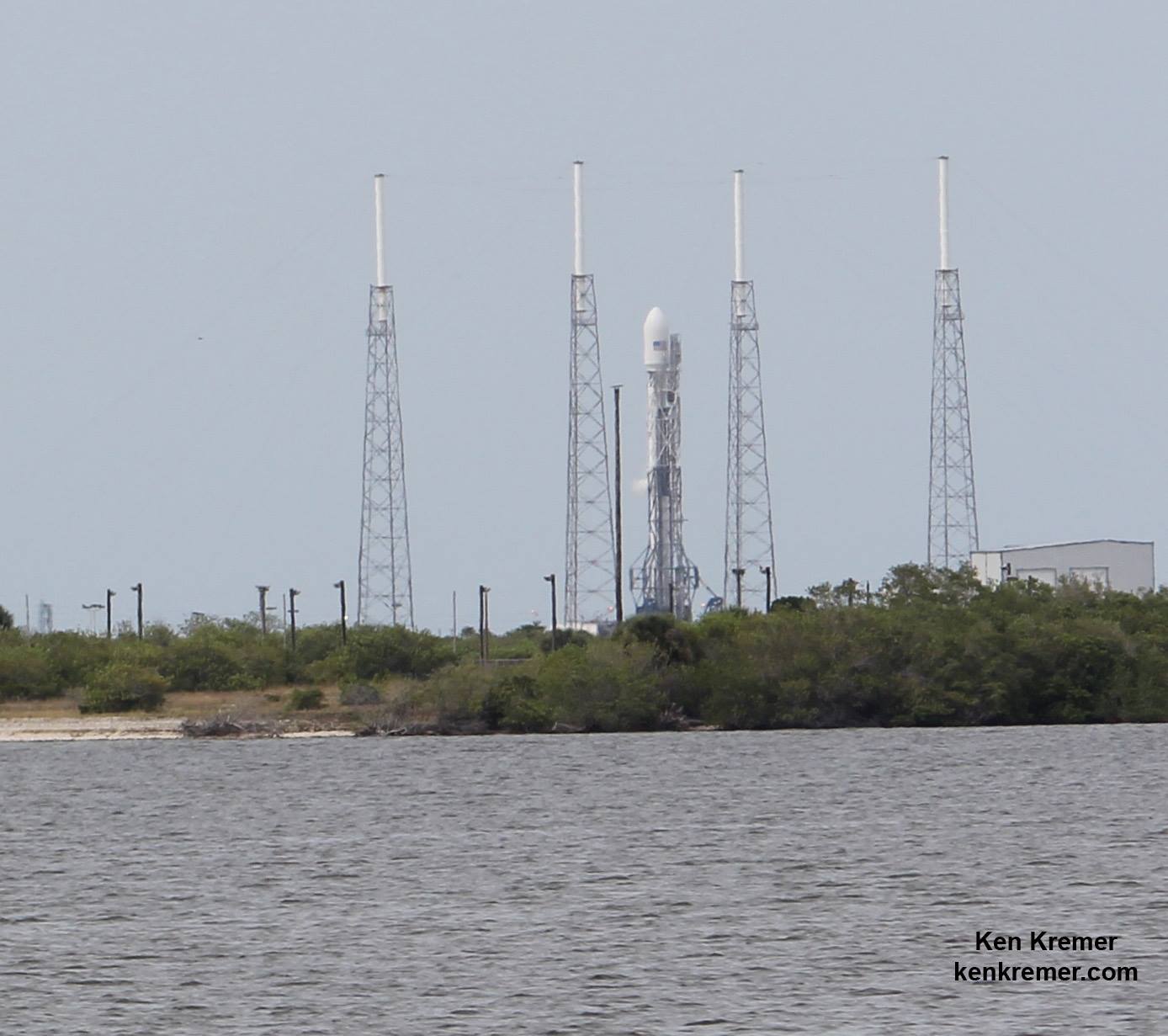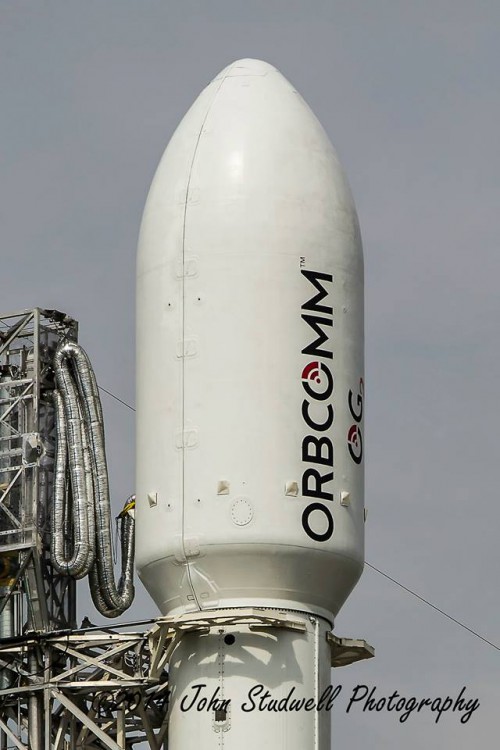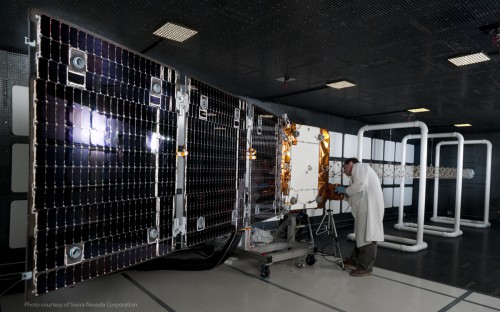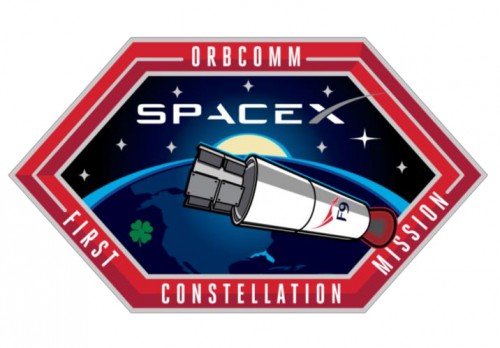
Six Orbcomm Generation-2 (OG-2) satellites must wait a little longer for their ride into low-Earth orbit, as SpaceX identified an apparent “pressure decrease” in the second stage of its Falcon 9 v1.1 rocket during final countdown operations on Friday, 20 June. Launch of the long-delayed mission was planned for 6:08 p.m. EDT, but was postponed until the very end of the 53-minute “window,” in the hope that engineers could identify the cause of the pressure decrease and determine whether it lay in the vehicle itself or within ground support equipment. Playing today’s launch attempt very close to the wire, SpaceX pressed on with a standard polling of all stations at T-13 minutes, but a “Hold, Hold, Hold” call was made from one of the flight controllers in the final minutes and the attempt was scrubbed. Although the mission has a second shot tomorrow (Saturday), it remains to be seen if the problems which prevented a launch today can be rectified in sufficient time.
Friday dawned with an initially pessimistic 30-percent likelihood of acceptable meteorological conditions, the 45th Weather Squadron having highlighted a low-pressure zone which threatened the Cape Canaveral area with cumulus clouds, thick clouds, anvil clouds, and a heightened risk of lightning. Nevertheless, SpaceX and Orbcomm, Inc., managers agreed to roll the Falcon 9 v.1.1 rocket—with the six OG-2 satellites snugly encapsulated within its bulbous payload fairing—horizontally out to Space Launch Complex (SLC)-40 at Cape Canaveral Air Force Station, Fla., at 1:00 a.m. EDT Friday. Upon arrival at the pad, the Falcon was raised to a vertical configuration, in order for technicians to install umbilicals and prepare for countdown operations.
Thirteen hours and 30 minutes before the scheduled 6:08 p.m. EDT opening of the launch window, the Falcon 9 v1.1 was powered-up and underwent an extensive checkout of the communications hardware, the Flight Termination System (FTS), and the navigational and control subsystems. As the day wore on, the weather situation seemed to improve and Air Force meteorologists adjusted their predictions slightly to a 40-percent likelihood of favorable conditions at the opening of the launch window. “A slow-moving tropical low, situated 30 nautical miles (55 km) to the east of the Cape is bringing layered cloudiness to the Cape this morning,” it was explained, but stressed that although “isolated rain showers are expected where the clouds are thicker in nature,” the majority of these showers would remain at least 15 nautical miles (27 km) offshore. Rain showers and thunderstorms were expected to be just inland on the sea breeze by liftoff time. It was also stressed that, in the event of a 24-hour scrub, the situation for a Saturday launch showed further improvement, with a 60-percent chance of acceptable weather.

At 2:20 p.m. EDT, Orbcomm announced that SpaceX had begun the lengthy procedure of fueling the Falcon 9 v1.1 with liquid oxygen and a refined form of rocket-grade kerosene, known as “RP-1.” A little over an hour later, the loading of liquid oxygen was completed and entered a “replenishment mode” to ensure that it was maintained at proper flight levels throughout the remainder of the countdown and any boiled-off oxidizer was rapidly replaced. This was visibly apparent to observers, as clouds of gas billowed around the booster. All propellants were confirmed loaded aboard the vehicle by about T-3 hours and 15 minutes. By the time SpaceX kicked off its live webcast at 5:35 p.m. EDT, Falcon 9 Product Director John Insprukter pointed out that Friday’s weather had been particularly dynamic, periodically shifting throughout the day between “Red” (“No-Go”) and “Green” (“Go”). With just over 30 minutes to go in the countdown, Mr. Insprukter noted that weather conditions had improved and were “Green” for an on-time launch.
However, at 5:53 p.m. EDT, about two minutes before the standard polling of all stations for their “Go/No Go” status at T-13 minutes and the subsequent initiation of the “terminal countdown” at T-10 minutes, the clock was abruptly halted. Although he had earlier made passing reference to a possible fuel leak, Mr. Insprukter expressed a measure of surprise to his webcast audience as the clock was recycled to track a revised T-0 at the very end of the launch window, at 7:01 p.m. He explained that the hold had been called in order to allow SpaceX engineers to take a closer look at a possible fuel leak in the Falcon 9 v1.1’s first stage. In an update at 6:35 p.m., Mr. Insprukter explained that a pressure decrease had been identified in the second stage, although it remained unclear if the problem lay with the Falcon 9 v1.1 itself or the ground support equipment. However, he stressed that both the Eastern Range and the weather remained “Green” and the OG-2 spacecraft were transitioned to internal power, as planned, after which the team would continue counting down to the T-13-minute polling point.
At 6:48 p.m., with 13 minutes remaining before the end of the window, the standard poll of all stations was conducted by Flight Director Brian Childers and, upon receipt of a unanimous “Green” (“Go for Launch”), the “terminal countdown” got underway at T-10 minutes. Now running on the “autosequencer,” at 6:54 p.m. the nine Merlin-1D engines of the Falcon 9 v1.1’s first stage underwent a “chill-down” protocol in order to provide pre-launch thermal conditioning. A mere 60 seconds later, the words “Hold, Hold, Hold” were called by a flight controller over the flight loop and the clock was stopped. With no further “wiggle room” in the launch window, an abort was called at 6:58 p.m. EDT and procedures were set in motion to “safe” the Falcon 9 on the pad. “The propellant will be offloaded and the vehicle and payloads will be returned to external power,” explained AmericaSpace’s Launch Tracker. “The next possible launch attempt is in 24 hours, but that will depend on the outcome of the review of the pressure-drop issue on the Falcon 9 second stage today.” Assuming that SpaceX can recycle and attempt a Saturday launch, weather conditions remain about 60-percent favorable.

The mission will insert the six OG-2 satellites into a circular orbit of 460 x 460 miles (750 x 750 km), inclined 52 degrees to the equator. They will remain in service for at least five years and provide two-way messaging services for global customers. Following a failed inaugural OG-2 launch in October 2012, tonight’s mission transported the first six of 17 OG-2 satellites, all built by Sierra Nevada Corp. (SNC), into low-Earth orbit. The remaining 11—which are currently undergoing final processing at SNC—are expected to fly aboard another Falcon 9 v1.1 later this year. Orbcomm announced in May 2008 that SNC would build 18 OG-2 satellites for a fee of $117 million, with an option for up to 30 others. A few weeks later, Orbcomm selected Argon ST, a subsidiary of Boeing, to develop advanced communications payloads to increase subscriber capacity by up to 12 times over earlier satellites, as well as transmitting data at higher speeds and quantities. Designed with Automatic Identification System (AIS), it is expected that the OG-2 network will be marketed by Orbcomm to U.S. and international coast guards and government agencies, as well as private security and logistics companies.
At the time of writing, 45 Orbcomm satellites have been delivered into orbit since July 1991, aboard a wide range of vehicles, including Europe’s Ariane 4, the air-launched Pegasus booster, Orbital Sciences Corp.’s Taurus, China’s Long March 4B, India’s Polar Satellite Launch Vehicle (PSLV), and Russia’s Cosmos-3M. Initial “Concept Demonstration Satellites” led to the OG-1 network and a replenishment series of “Quick Launch” missions, with the OG-2 series intended to supplement and eventually replace the first generation. “Due to their high efficiency and modular design, these satellites have substantially more capacity to service a larger number of subscribers, thus making the network more efficient with few satellites than the OG-1 satellites that are currently in orbit,” explained Pat Remias, SNC’s Space Systems senior director of programs. “SNC has established a satellite production line in our Louisville facility to integrate and test each vehicle rapidly, with up to six satellites processing simultaneously.”
By 2009, Orbcomm had settled on SpaceX’s Falcon 9 as its vehicle of choice, with the inaugural launches originally anticipated the following year, but postponed several times due to delays and schedule slips. The first OG-2 “prototype” satellite was launched in October 2012, flying “piggyback” alongside SpaceX’s CRS-1 Dragon. However, an upper stage engine shortfall caused it to be inserted into a low orbit of just 125 x 200 miles (200 x 320 km), instead of the planned 220 x 470 miles (350 x 750 km). Despite the successful deployment of the satellite from the final stage of the Falcon 9, it quickly became clear that the low orbit was “unworkable” and the first OG-2 re-entered the atmosphere to destruction a few days later.
In preparation for the next batch of OG-2 launches, four satellites arrived at Cape Canaveral Air Force Station from SNC shortly after noon EDT on 21 April 2014, followed by two others on the 26th. Each satellite weighs 380 pounds (172 kg) and, when fully deployed in orbit, will measure 42.7 feet (13 meters) x 3.3 feet (1 meter) x 1.6 feet (0.5 meters) and generate about 400 watts of electrical power. The satellites underwent extensive checks and fueling of their hydrazine attitude-control systems, and on 6 May SpaceX performed a Flight Readiness Review and confirmed its status as “Go” for launch on the 10th. The payload stack, containing the six satellites on their Expendable Launch Vehicle Secondary Payload Adaptor (ESPA) “ring,” was subsequently encapsulated within the bulbous Falcon 9 v1.1 fairing and attached to the rocket.

Rollout to SLC-40 occurred early Thursday, 8 May, after which SpaceX intended to conduct a standard static “hot-fire” test of the nine Merlin-1D first-stage engines. However, a considerable helium leak on the first stage caused the hot fire to be postponed by 24 hours, then scrubbed indefinitely. “Today’s attempt to perform the static firing test was stopped while the rocket was being fueled,” explained Orbcomm on the 9th. “Both the OG-2 satellites and the rocket are in safe condition and will be rotated horizontal and rolled back into the integration facility. This will prevent us from launching this weekend.” Hardware from the first stage was removed and returned to SpaceX’s facility in Hawthorne, Calif., for inspections and verifications to ensure that the problem did not represent a systemic failure and a threat to future missions.
On 19 May, a revised target of 11 June was announced and it was noted that the Orbcomm and SNC processing teams would arrive at the Cape about a week before launch to participate in the lengthy process of re-encapsulating the OG-2 satellites back into their adaptor. By the end of May, the launch had moved a further 24 hours to the right and on 10 June Orbcomm revealed a new target of No Earlier Than the 15th. “During final integration on one of the OG-2 spacecraft,” it was explained, “we encountered a minor issue resulting in a few extra days of delay to perform precautionary steps to ensure there are no operational concerns with the satellite.” In the meantime, last Friday, SpaceX performed a successful static hot-fire test, but it was feared that upcoming maintenance of Eastern Range tracking assets might result in a further delay until July. However, after “finalizing the launch schedule with the Range at the Cape”—a new date of 20 June was issued.
Want to keep up-to-date with all things space? Be sure to “Like” AmericaSpace on Facebook and follow us on Twitter: @AmericaSpace
Missions » Commercial Space » ORBCOMM » SpaceX OG2 M1 »



So a new Falcon 9 has yet another launch delay, but Musk continues to assure that soon they will be reusing these same stages 1,000 times with a 24 hour turn around schedule.
Time will tell, but a certain amount of skepticism would seem advisable.
Falcon Nine…….the YUGO of the rocket business……
Yet Musk continues to assert that SpaceX will soon be flying a reusable Falcon 9 with only a one day turnaround.
Perhaps, but considerable skepticism would seem advisable.
Another nervous ULA employee, eh?
No, but suppose I were, what part of the stated facts would that invalidate?
1000 times sounds like hype to me. Go ahead and launch is how we lost 7 lives. Orbcomm is still content and prefers delays to loss of equipment.
There is no contradiction in a new vehicle having issues and launching used vehicles. All vehicles have issues.
“1000 times sounds like hype to me.”
Sounds like hype to me as well, but that is what Musk has said repeatedly. He also said the part about one day turnarounds, while they are having trouble launching an unused rocket once within a month of the original launch date.
That is precisely why I said considerable skepticism would seem advisable.
“There is no contradiction in a new vehicle having issues and launching used vehicles.”
There is a contradiction between a non-reusable vehicle not being able to launch on time and claiming you will soon be launching a reusable version of the same vehicle 1,000 times with only a day between each reuse.
It may make good hype, but it is not credible. SpaceX would be a lot better off trying to get the non-reusable Falcon 9 to work reliably before making such grandiose claims.